Giving collisions a new shape: New ATLAS result measures isotropy of LHC events
14 July 2023 | By
A lot can happen when you slam two protons together at nearly the speed of light! Inside the proton, the strong force acts between quarks and gluons, generating a diverse array of energy flow patterns. Understanding these patterns is pivotal for the study of quantum chromodynamics (QCD), the theory that describes the strong force. When studying the shape of LHC collision events, physicists ask: how similar or different is their energy flow? The ATLAS Collaboration recently published a measurement of new collision event shapes in high-energy multijet events at the LHC, including those with the configurations illustrated below (jets indicated by cones).

Measurements of shape observables have been used in many results including the observation of the gluon in 3-jet events by the JADE collaboration in 1980. These observables describe energy flow in terms of geometry. For example, the ‘thrust’ describes how ‘back-to-back’ an event is, or whether an event’s energy is concentrated along a particular axis (small values of thrust) or evenly-distributed (large values of thrust). In terms of thrust, a two-jet event looks very different from a three- or six-jet event – but these latter events have values of thrust that are very similar to each other.

Physicists borrowed analysis techniques from the field of computer vision to gain a fresh perspective on event shapes, making the “distance” between energy patterns concrete in a mathematical sense.

Theoretical physicists have borrowed analysis techniques from the field of computer vision to gain a fresh perspective on event shapes, making the “distance” between energy patterns concrete in a mathematical sense. The Energy-Mover’s Distance (EMD) quantifies the minimum amount of work required to rearrange one energy flow pattern into another, by moving quantities of energy across certain distances. This process, called optimal transport, allows scientists to establish a measure of distance between collider events.
Event observables can be reformulated in terms of optimal transport problems between LHC events and symmetric, reference arrangements of particles. The thrust can be reframed as the EMD in the transverse plane between a collider event and a back-to-back pair of particles. If more ‘work’ is needed to re-arrange the event into the reference pattern, the EMD is larger, and so is the difference between event shapes!

In their new analysis, ATLAS researchers measured event shapes defined in terms of the distance between collider events and novel reference geometries. These are measures of the event isotropy, which determines the distance between a collider event and a uniform distribution of particle energy in the transverse plane (resembling a continuous ring).
This event shape is sensitive to different energy-flow configurations than thrust. Back-to-back events are a large distance from an isotropic ring and are assigned large values, while events with larger numbers of well-balanced objects resemble the ring more and more closely, and so take small values. The three multijet events above are strongly-ordered in terms of the event shape below.

ATLAS researchers compared the measured event isotropy distribution to advanced QCD predictions: none accurately accounted for the observed frequency of isotropic events.

Measurements of event isotropy allow physicists to identify events with isotropic energy flow patterns rarely produced by the strong interaction, giving them new avenues for understanding challenging aspects of the Standard Model. ATLAS researchers compared the measured event isotropy distribution to advanced predictions of QCD radiation patterns in LHC multijet events: none of the predictions accurately accounted for the observed frequency of isotropic events.
Analyses like this can be used to improve the accuracy of QCD simulations, which are among the most widely-used theoretical tools in LHC research. Observables such as event isotropy can also offer insights into exotic phenomena that are not predicted by the Standard Model, including the potential production of black holes.
An improved understanding of how these isotropic energy flow patterns are produced by Standard Model interactions will help ensure ATLAS researchers are able to spot new physics wherever it may appear!
Learn more
- Measurements of multijet event isotropies using optimal transport with the ATLAS detector (arXiv:2305.16930, see figures)
- C. Cesarotti and J. Thaler, A Robust Measure of Event Isotropy at Colliders (arXiv:2004.06125)
- P. T. Komiske, E. M. Metodiev, and J. Thaler, The Metric Space of Collider Events (arXiv:1902.02346)




